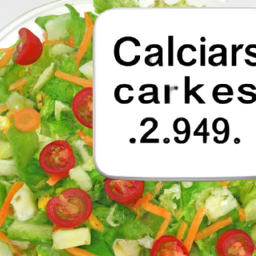Calories in Salad Garden Salad
How Many Calories In A Garden Salad
How Many Calories in a Garden Salad?
Garden salads are a delicious and nutritious food item that can be served as a main dish, side, or part of a larger meal. The ingredients that go into making a garden salad will vary from person to person, and each individual ingredient can have an effect on the overall calorie count. In this article, we will delve into the features, benefits, pros & cons, case studies, FAQs, mistakes people make, and best practices for preparing a garden salad that will help you determine how many calories are in a garden salad.
Features
Garden salads can be made with a variety of ingredients. The most commonly used ingredients include lettuce, tomatoes, cucumbers, carrots, bell peppers, olives, onions, and herbs. Other ingredients such as cheeses, proteins (chicken, tuna, etc.), nuts, and seeds can also be added to a garden salad to increase its nutritional value and add flavor.
Benefits
Garden salads are a great way to get in a serving of fresh vegetables. The different ingredients in a garden salad can provide various vitamins and minerals that are essential for good health. Additionally, garden salads can be used as a low-calorie dish, as some salads can have as few as 50 calories per serving.
Pros & Cons
The pros of adding a garden salad to your diet are numerous. Garden salads can provide essential nutrients, vitamins, and minerals, as well as being low in calories, fat, and cholesterol. On the other hand, some garden salads can be high in sodium, depending on what types of dressings, cheeses, and proteins are used.
Case Studies
Case Study 1: A woman in her early thirties is looking to add more vegetables to her diet. She decides to make a garden salad with lettuce, tomatoes, cucumbers, bell peppers, onions, and olives. The garden salad is low in calories, and the selection of vegetables provides her with essential nutrients and vitamins that she needs for good health.
Case Study 2: A family of four is looking for a healthy meal that doesn't take too long to make. For dinner, they decide to make a garden salad with lettuce, tomatoes, carrots, bell peppers, onions, and boiled eggs. The salad is a great source of protein and other vitamins and minerals. Additionally, it is low in calories and the family can enjoy it as a side or main dish.
FAQs
Q: How many calories are in a garden salad?
A: The number of calories in a garden salad will vary depending on the ingredients used and the portion size. The average garden salad made with lettuce, tomatoes, cucumbers, bell peppers, onions, and olives contains approximately 50-100 calories.
Q: Can I add protein to my garden salad?
A: Absolutely! Adding a source of protein to a garden salad is a great way to increase its nutritional value and make it a more filling meal. You can add cooked chicken, tuna, eggs, or any other source of lean protein to your garden salad.
Mistakes People Make
One common mistake people make when preparing a garden salad is adding too much dressing. Many people use dressings such as ranch, Caesar, or vinaigrette to add flavor to their salads. However, these dressings can be high in fat and calories, so it's best to opt for a light dressing such as a citrus-based vinaigrette or a red wine vinegar and olive oil mixture.
Another mistake people make with garden salads is adding too many high-calorie ingredients. For example, adding croutons, bacon, or cheese to a garden salad will dramatically increase its calorie count.
Best Practices
The best practice for making a nutritious and healthy garden salad is to stick to the basics. Use lettuce as the base for your salad and then add other vegetables such as tomatoes, cucumbers, bell peppers, and onions. For added flavor, you can add olives, boiled eggs, nuts, seeds, and herbs. When it comes to dressing, always choose a light dressing such as a vinaigrette, red wine vinegar, or olive oil.
Summary
In conclusion, garden salads are a delicious and healthy food that can be enjoyed as a main dish, side, or part of a larger meal. Many different ingredients can be added to a garden salad, and each ingredient can have an effect on the overall calorie count. It's important to stick to the basics when making a garden salad and to be mindful of adding too much dressing or high-calorie ingredients. By following these guidelines, you can ensure that your garden salad is low-calorie and full of essential vitamins and minerals.
Final Notes
Garden salads can be a great source of nutrients and a delicious way to get in a serving of vegetables. It's important to be aware of how many calories are in a garden salad, as well as the different ingredients that are being added. By following the tips outlined in this article, you can create the perfect garden salad that is both nutritious and delicious.
Conclusion
Garden salads are an easy and nutritious way to enjoy a variety of vegetables. In this article, we discussed the features, benefits, pros & cons, case studies, FAQs, mistakes people make, and best practices for preparing a garden salad. By following these guidelines, you can create a garden salad that is low in calories and high in essential vitamins and minerals.

Previous Page
Next Page
